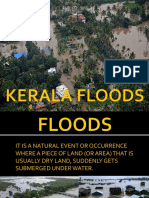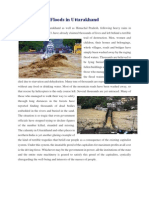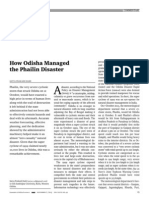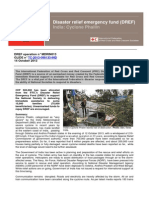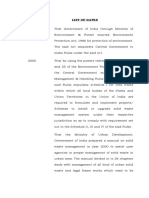0 ratings0% found this document useful (0 votes)
309 viewsUttrakhand Disaster
Uttrakhand Disaster
Uploaded by
Rakesh KumarThe document summarizes the 2013 Uttarakhand floods in India. From June 15-18, the state received unprecedented heavy rainfall that was over 375% of the normal monsoon amount. This caused widespread flooding and landslides that destroyed infrastructure and homes, killed over 6,000 people, and stranded tens of thousands of pilgrims. Rescue efforts involved the Indian armed forces, disaster response teams, and volunteers in difficult conditions. The floods were considered one of India's worst natural disasters and had extensive economic and human costs. Analysis suggested the disaster was exacerbated by factors like climate change, deforestation, and rapid infrastructure development including hydroelectric projects.
Copyright:
© All Rights Reserved
Available Formats
Download as PPTX, PDF, TXT or read online from Scribd
Uttrakhand Disaster
Uttrakhand Disaster
Uploaded by
Rakesh Kumar0 ratings0% found this document useful (0 votes)
309 views15 pagesThe document summarizes the 2013 Uttarakhand floods in India. From June 15-18, the state received unprecedented heavy rainfall that was over 375% of the normal monsoon amount. This caused widespread flooding and landslides that destroyed infrastructure and homes, killed over 6,000 people, and stranded tens of thousands of pilgrims. Rescue efforts involved the Indian armed forces, disaster response teams, and volunteers in difficult conditions. The floods were considered one of India's worst natural disasters and had extensive economic and human costs. Analysis suggested the disaster was exacerbated by factors like climate change, deforestation, and rapid infrastructure development including hydroelectric projects.
Original Description:
presentation for disaster in uttrakhand
Copyright
© © All Rights Reserved
Available Formats
PPTX, PDF, TXT or read online from Scribd
Share this document
Did you find this document useful?
Is this content inappropriate?
The document summarizes the 2013 Uttarakhand floods in India. From June 15-18, the state received unprecedented heavy rainfall that was over 375% of the normal monsoon amount. This caused widespread flooding and landslides that destroyed infrastructure and homes, killed over 6,000 people, and stranded tens of thousands of pilgrims. Rescue efforts involved the Indian armed forces, disaster response teams, and volunteers in difficult conditions. The floods were considered one of India's worst natural disasters and had extensive economic and human costs. Analysis suggested the disaster was exacerbated by factors like climate change, deforestation, and rapid infrastructure development including hydroelectric projects.
Copyright:
© All Rights Reserved
Available Formats
Download as PPTX, PDF, TXT or read online from Scribd
Download as pptx, pdf, or txt
0 ratings0% found this document useful (0 votes)
309 views15 pagesUttrakhand Disaster
Uttrakhand Disaster
Uploaded by
Rakesh KumarThe document summarizes the 2013 Uttarakhand floods in India. From June 15-18, the state received unprecedented heavy rainfall that was over 375% of the normal monsoon amount. This caused widespread flooding and landslides that destroyed infrastructure and homes, killed over 6,000 people, and stranded tens of thousands of pilgrims. Rescue efforts involved the Indian armed forces, disaster response teams, and volunteers in difficult conditions. The floods were considered one of India's worst natural disasters and had extensive economic and human costs. Analysis suggested the disaster was exacerbated by factors like climate change, deforestation, and rapid infrastructure development including hydroelectric projects.
Copyright:
© All Rights Reserved
Available Formats
Download as PPTX, PDF, TXT or read online from Scribd
Download as pptx, pdf, or txt
You are on page 1of 15
UTTARAKHAND
DISASTER: MAN MADE
OR NATURES FURY..
Overview of Uttarakhand
Flooding in Uttrakhand
Other affected regions
How local people looted pilgrims.
Consequences
Rescue and relief operations.
Causes of the disaster
Measures to reduce the intensity
Uttarakhand has a total
land area of
53,584sqkm of which
94% is mountaneous.
Most of the area is
covered by himalayan
peaks and glaciers.
Two major rivers(Ganga
and yamuna) originate
from the glaciers of
uttarakhand
BADRINATH TEMPLE
KEDARNATH TEMPLE
GANGOTRI TEMPLE YAMONOTRI TEMPLE
From 15 to 18 June
2013, Indian state
of Uttrakhand and
adjoining area received
heavy rainfall, which was
about 375 percent more
than the benchmark
rainfall during a normal
monsoon.
16
th
and 17
th
June,2013
The Day of Destruction
happened in history of
UTTRAKHAND
FLOODING IN UTTRAKHAND
The massive rainfall and cloud
burst events were happening at
multiple places, including in
Bhagirathi basin, Assiganga basin,
Mandakini Basin, Badrinath region,
other places in Alaknanda region
from 15 June 2013 to around 18
June 2013.
It is considered to be the largest natural disaster after tsunami occurred in
2004
This lead to melting
of Chorabari Glacier at the
height of 3800 metres, and
eruption of the Mandakini
River which led to heavy floods
near Kedar Dome, Rudraprayag
district, Uttarakhand, Himachal
Pradesh.
CONSEQUENCES:HUMAN LOSS
Landslides, due to the floods,
damaged several houses and
structures, killing those who
were trapped Over 70,000
people were stuck.
According to the official records
400 houses were destroyed and
265 were damaged
4,200 villages were victims of
the floods
6,000 people were dead,10,000
were injured and 1,00,000 were
stuck in the valley
Major roads,telephone towers were
destroyed due to which
communication with the outer world
was lost.
Tourism constitutes about 30% of
the states income which was lost
All the shops and hotels were
destroyed and all roads were
broken
CONSEQUENCES:ECONOMIC LOSS
20,000 crores loss was
reported,which may be in the form
of destruction of houses roads,cars
e.t.c
RESCUE AND RELIEF OPERATION
The Army, Air Force, Navy, Indo-Tibetan
Border Police (ITBP), Border Security Force,
National Disaster Response
Force (NDRF), Public Works Department and
local administrations worked together for
quick rescue operations.
Several thousand soldiers were deployed for
the rescue missions.
Activists of political and social organizations
are also involved in the rescue and
management of relief centres.
Helicopters were used to rescue people, but
due to the rough terrain, heavy fog and
rainfall, maneuvering them was a challenge.
By 21 June 2013, the Army had
deployed 10,000 soldiers and 11
helicopters,
the Navy had sent 45 naval
divers, and the Air force had deployed
43 aircraft including 36 helicopters.
From 17 June to 30 June 2013, the IAF
airlifted a total of 18,424 people - flying
a total of 2,137 sorties and
dropping/landing a total of 3,36,930 kg
of relief material and equipment.
Prime Minister of India undertook an
aerial survey of the affected areas and
announced 1,000 crore (US$170 million
) aid package for disaster relief efforts
in the state. Several state governments
announced financial assistance,
Special trains were employed by
the government all over the
country to cater the needs of the
flood victims
Indian army showed extreme levels
of courage in saving the people in
spite of the helicopter crash
occurred during the mission-
operation Rahat.
Melting of glaciers, because of
global warming has been of the
reasons. Pollution and global
warming accounted for the melting
of glaciers
Violation of environmental laws and
deforestation has also accounted
for floods.
Building of hydro electricity plants
and increase in the infrastructural
facilities have weaken the mountain
causing land slides.
CAUSES OF THE DIASTER
Ecologists point out that the huge
expansion of hydro-power projects
and construction of roads to cope with
the lakhs of tourists in Uttarakhand
and Himachal Pradesh has
compounded the scale of the disaster
Currently 70 dams exist in the Char
dham area alone.The dam
constructions involve blasting of hills
which increase the risk of land slides.
More than 220 power and mining
projects are running in 14 river valleys
in Uttrakhand.
Several rivers are being diverted
through tunnels for these projects
leadung to major disasters in the state.
Protecting the environment can
only be the way to reduce the
risk of such disasters
Putting cap on number of
tourists may be a solution,
which reduces the construction
of hotels, expansion of roads.
Keeping a check on illegal
constructions and on
deforestation.
Using latest equipments to
predict the probability of rains
Alerting and transferring
people to safe zones at proper
time.
Training the people on how to
take basic safety measures.
You might also like
- A Case Study of "Uttarakhand Flood 2013": Prepared By: Kusum Dahal (720111)Document42 pagesA Case Study of "Uttarakhand Flood 2013": Prepared By: Kusum Dahal (720111)Kusum DahalNo ratings yet
- Uttrakhand FloodsDocument16 pagesUttrakhand FloodsPriya Reddy VaddeNo ratings yet
- Presented By: Pooja Baluja Nirav Desai Bipin Prajapati Aasim Shaikh Sawan JainDocument38 pagesPresented By: Pooja Baluja Nirav Desai Bipin Prajapati Aasim Shaikh Sawan Jaingettopoonam100% (2)
- Utarakhand Flood Case StudyDocument44 pagesUtarakhand Flood Case StudyDinesh RamoNo ratings yet
- Presentation On Uttrakhand FloodDocument26 pagesPresentation On Uttrakhand FloodSaddam AnsariNo ratings yet
- Uttarakhand Disaster (Himalayan Tsunami) (June 2013)Document19 pagesUttarakhand Disaster (Himalayan Tsunami) (June 2013)inshaNo ratings yet
- UttarakhandDocument35 pagesUttarakhandSupriya MahantaNo ratings yet
- Krish Manwani Aman Semwal Adamya Vikram Singh Harsh Sharma Pranjal Seluriyal Kartik Arora Priyambad SumanDocument11 pagesKrish Manwani Aman Semwal Adamya Vikram Singh Harsh Sharma Pranjal Seluriyal Kartik Arora Priyambad SumanHARSH SHARMANo ratings yet
- Op Jindal University: Submitted To Dr. Sanjay Kumar Singh Submitted by Sushant Prasad ShahDocument8 pagesOp Jindal University: Submitted To Dr. Sanjay Kumar Singh Submitted by Sushant Prasad ShahSushant ShahNo ratings yet
- Keralafloods 190526105542Document17 pagesKeralafloods 190526105542dineshkumar rNo ratings yet
- Man-Made Havoc: (Uttrakhand Disaster-2013)Document26 pagesMan-Made Havoc: (Uttrakhand Disaster-2013)Akshit KalaNo ratings yet
- Dim Assienment 20052311011 PDFDocument24 pagesDim Assienment 20052311011 PDFAayush PatelNo ratings yet
- Rehabilitation Issues and Case Study of Kedarnath LandslideDocument46 pagesRehabilitation Issues and Case Study of Kedarnath Landslidebittumonster5888100% (3)
- The Hindu E-Paper Document Kerala and LandslidesDocument3 pagesThe Hindu E-Paper Document Kerala and Landslidesaryansingh.infinity360No ratings yet
- Cyclone Hudhud (2018b2a40535h)Document3 pagesCyclone Hudhud (2018b2a40535h)SAINATHNo ratings yet
- SST Disaster Management ProjectDocument13 pagesSST Disaster Management Projectishaanbiswas03No ratings yet
- A Case Study of Natural Disaster Caused by Cyclone in IndiaDocument10 pagesA Case Study of Natural Disaster Caused by Cyclone in IndiaAnindita RoyNo ratings yet
- Floods in Uttarakhan1Document3 pagesFloods in Uttarakhan1Kosygin LeishangthemNo ratings yet
- Impact of Kedarnath Flood Tragedy On Ecological and Socio-Economic Setup: A Geographical StudyDocument7 pagesImpact of Kedarnath Flood Tragedy On Ecological and Socio-Economic Setup: A Geographical StudyJhalak VarshneyNo ratings yet
- Narmada DamFinalDocument24 pagesNarmada DamFinalShilpa Ingle100% (7)
- How Odisha Managed The Phailin Disaster PDFDocument4 pagesHow Odisha Managed The Phailin Disaster PDFR K MeenaNo ratings yet
- Kerala Floods Case StudyDocument11 pagesKerala Floods Case StudyNisar Mohammed100% (1)
- Flood Risk and Vulnerability Mapping Usng Gis A Nepal Case StudyDocument10 pagesFlood Risk and Vulnerability Mapping Usng Gis A Nepal Case StudyGentur AdieNo ratings yet
- 2006 Tsunami 1Document9 pages2006 Tsunami 1Vishal MohanNo ratings yet
- Evs Set 2 AssgnDocument17 pagesEvs Set 2 Assgnabhi abhiNo ratings yet
- Uk Flood ProjectDocument11 pagesUk Flood ProjectDiya DobhalNo ratings yet
- Evs ProjectDocument19 pagesEvs ProjectShubhamAgrawal0% (2)
- Assignment Riya SharmaDocument7 pagesAssignment Riya SharmaArjun NehraNo ratings yet
- 5 Pages After MapDocument7 pages5 Pages After Mapironadit2007No ratings yet
- Presentation 2 5Document28 pagesPresentation 2 5krishbistNo ratings yet
- Environmental Impact Assessment of Uttarakhand Disaster-264 PDFDocument8 pagesEnvironmental Impact Assessment of Uttarakhand Disaster-264 PDFAr Abhinav SrivastavNo ratings yet
- Report On Kerala Floods PDFDocument20 pagesReport On Kerala Floods PDFsachin balyanNo ratings yet
- Report On Kerala FloodsDocument20 pagesReport On Kerala FloodsDaijo Poruthur67% (3)
- 5 Geographical Study On District Action Plan For UttarkashiDocument4 pages5 Geographical Study On District Action Plan For UttarkashiS SinghNo ratings yet
- 2004 Sumatra Earthquake and Indian Ocean Tsunami: DescriptionDocument12 pages2004 Sumatra Earthquake and Indian Ocean Tsunami: Descriptiondaniyal rasheedNo ratings yet
- Created by Pankaj Kumar BBA IV Semester Disaster ManagementDocument5 pagesCreated by Pankaj Kumar BBA IV Semester Disaster ManagementPankaj KumarNo ratings yet
- Uttrakhand Disaster 2013Document20 pagesUttrakhand Disaster 2013ayushNo ratings yet
- EnvironmentDocument10 pagesEnvironmentaskmeeNo ratings yet
- Status Report On Periyar River - Dr.M.L.josephDocument46 pagesStatus Report On Periyar River - Dr.M.L.josephRavanan AmbedkarNo ratings yet
- Recent Disasters Expose Government's True CapabilitiesDocument11 pagesRecent Disasters Expose Government's True CapabilitiesThavam RatnaNo ratings yet
- Demystifying A Himalayan TragedyDocument11 pagesDemystifying A Himalayan TragedyAmit Kumar100% (1)
- Cyclone TauktaeDocument16 pagesCyclone TauktaeSona Parveen FarooqueNo ratings yet
- Cyclone Thane 2021Document11 pagesCyclone Thane 2021karthickNo ratings yet
- Kerala Floods - Background PaperDocument6 pagesKerala Floods - Background PaperlynxtpllynxNo ratings yet
- A case study of Wayanad Landslide in KeralaDocument11 pagesA case study of Wayanad Landslide in KeralaAshish KumarNo ratings yet
- Kerala Flood Case Study-2018Document5 pagesKerala Flood Case Study-2018Soumith M 18BME0862No ratings yet
- Holiday HomeworkDocument50 pagesHoliday HomeworkOm TechnologiesNo ratings yet
- Kerala Flood KULDEEPDocument16 pagesKerala Flood KULDEEPSauravDagur100% (2)
- Uttarakhand Disaster 2013 Lessons Learnt: Dr. Anil K. GuptaDocument30 pagesUttarakhand Disaster 2013 Lessons Learnt: Dr. Anil K. GuptaEtee AgrawalNo ratings yet
- Enhancing Disaster Resilience Through Alternative Approaches in Planning: A Case Study of Jagatsinghpur, OdishaDocument9 pagesEnhancing Disaster Resilience Through Alternative Approaches in Planning: A Case Study of Jagatsinghpur, OdishaKasturi MandalNo ratings yet
- Page101 Mehedi PapDocument13 pagesPage101 Mehedi Papmurad_ceNo ratings yet
- Disaste R Managemen T: Submitted byDocument11 pagesDisaste R Managemen T: Submitted byAkshit KalaNo ratings yet
- Flood Affected Areas in UttarakhandDocument20 pagesFlood Affected Areas in Uttarakhandtyagi5888No ratings yet
- Bibliometric Analysis of Flood Risk Research A Review Ijariie22690Document9 pagesBibliometric Analysis of Flood Risk Research A Review Ijariie22690ntsuandihNo ratings yet
- Climate ChangeDocument5 pagesClimate ChangeAryaNo ratings yet
- #32 Geography News-LetterDocument62 pages#32 Geography News-Lettervikassharma9863No ratings yet
- Major Historical Disasters in India - Bharat Katha - GS SCOREDocument3 pagesMajor Historical Disasters in India - Bharat Katha - GS SCOREVinit GuptaNo ratings yet
- Relief CrossDocument7 pagesRelief Crosspathanfor786No ratings yet
- Pallavi Gupta, MBA-HRDocument1 pagePallavi Gupta, MBA-HRRakesh KumarNo ratings yet
- Leaf MorphologyDocument12 pagesLeaf MorphologyRakesh Kumar100% (1)
- The Browning VersionDocument7 pagesThe Browning VersionRakesh Kumar0% (1)
- Political PartyDocument6 pagesPolitical PartyRakesh KumarNo ratings yet
- Final Report On Library Management SystemDocument44 pagesFinal Report On Library Management SystemRakesh KumarNo ratings yet
- Database Management SystemDocument1 pageDatabase Management SystemRakesh KumarNo ratings yet
- 007 LodhiDocument3 pages007 LodhiRakesh KumarNo ratings yet
- DR Faustus A Tragic HeroDocument3 pagesDR Faustus A Tragic HeroRakesh Kumar100% (6)
- Information Technology ScienceDocument22 pagesInformation Technology ScienceRakesh KumarNo ratings yet
- Question AreDocument2 pagesQuestion AreRakesh KumarNo ratings yet
- Notification of Indian Air Force Group X Technical Group Y Non TechnicalDocument8 pagesNotification of Indian Air Force Group X Technical Group Y Non TechnicalCareerNotifications.comNo ratings yet
- Air Force Directory 2012Document17 pagesAir Force Directory 2012Real_LaviNo ratings yet
- IafDocument11 pagesIafSapana MadasNo ratings yet
- TPCRDocument82 pagesTPCRkishore13No ratings yet
- Aircraft Accidents, Indian Air Force, 2003-2004Document31 pagesAircraft Accidents, Indian Air Force, 2003-2004BeasF137No ratings yet
- RRR Final CompressedDocument77 pagesRRR Final Compressedraaz66526No ratings yet
- A Salute To The Brave Women SoldiersDocument5 pagesA Salute To The Brave Women SoldiersDhairya PatelNo ratings yet
- VayuDocument104 pagesVayuKarthikeyanNo ratings yet
- Salient Points To Remember Prior To Seeking Appointment For Class 1 Medical ExaminationDocument9 pagesSalient Points To Remember Prior To Seeking Appointment For Class 1 Medical ExaminationBhuvan ChandraNo ratings yet
- Indo-Pakistani War of 1965 - Wikipedia PDFDocument197 pagesIndo-Pakistani War of 1965 - Wikipedia PDFAbdul QudoosNo ratings yet
- Flood Scene Remains Grim, Death Toll 103: First Batch of Five Rafale Jets Takes Off From France To IndiaDocument12 pagesFlood Scene Remains Grim, Death Toll 103: First Batch of Five Rafale Jets Takes Off From France To Indiadr. putul mahantaNo ratings yet
- IIAEIT Final BrochureDocument28 pagesIIAEIT Final BrochureRahul SharmaNo ratings yet
- List of DatesDocument30 pagesList of DatesshivendugaurNo ratings yet
- Shuhda HistoryDocument3 pagesShuhda HistoryMunaz AttNo ratings yet
- AI2013 - Takeoff Magazine - AI SpecialDocument49 pagesAI2013 - Takeoff Magazine - AI Specialcheenu100% (2)
- The Indian Air ForceDocument26 pagesThe Indian Air ForceavemariaenglishacademyNo ratings yet
- Air War Strategy in 1971Document65 pagesAir War Strategy in 1971K M Ashbarul Bari100% (1)
- Indian Defence Industry Redefining - Frontiers WebDocument80 pagesIndian Defence Industry Redefining - Frontiers Webkishore13100% (2)
- Self Study 10th STD Unit 1Document12 pagesSelf Study 10th STD Unit 1navinghegadmal9No ratings yet
- History Book ReviewDocument23 pagesHistory Book ReviewManeesh ReddyNo ratings yet
- IAF E-Calendar 2022Document14 pagesIAF E-Calendar 2022Mayank Ghatpande100% (1)
- Indian Armed ForcesDocument27 pagesIndian Armed ForcesHarshil AroraNo ratings yet
- 'Agnipath' For Air ForceDocument7 pages'Agnipath' For Air ForceNDTV100% (1)
- Year End Review of Ministries PDFDocument237 pagesYear End Review of Ministries PDFVijay RaiNo ratings yet
- Medical Cell: Procedure & Training ManualDocument73 pagesMedical Cell: Procedure & Training ManualSanket100% (1)
- Within Site On The Web: Know UsDocument13 pagesWithin Site On The Web: Know UsathipathyNo ratings yet
- HAL Hands Over Light Combat Aircraft Tejas To IAFDocument14 pagesHAL Hands Over Light Combat Aircraft Tejas To IAFManoj Paul JohnNo ratings yet
- True Observing India 15september-2023Document8 pagesTrue Observing India 15september-2023Rachit AgarwalNo ratings yet
- Jan 2021 PDFDocument91 pagesJan 2021 PDFDeshraj SehraNo ratings yet
- Updated Attendees List IHSTDocument19 pagesUpdated Attendees List IHSTVijay BB News InternationalNo ratings yet









